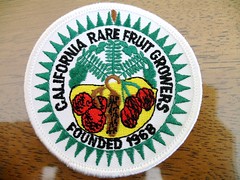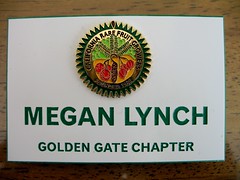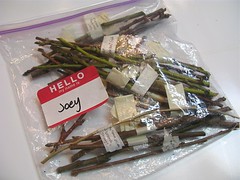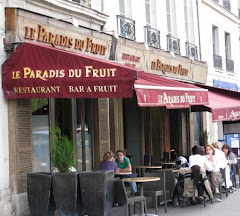Our chapter covers a broad area so sometimes the meetings are farther away than people feel like going. I'd like to see members using the Golden Gate CRFG Discussion List to offer and look for rides to meetings and other CRFG events. To that end, let me state that I'm happy to drive a couple people from near Ashby BART to the meeting at the El Sobrante Library on the 8th. The only caveat is that I have to be there to set up and break down so if you're with me, you're going to be there from 12:30ish to 4:15ish...
I'd especially like to see ride offers from members from SF, the North Bay and Contra Costa County who are planning on coming to the meeting. It's a great way to get to know people, to boost meeting attendance (which will really work in your favor this time since we're looking to get info from our members), to reduce your carbon footprint.
For those getting rides, it's always good etiquette to share gas and toll expenses. Especially with gas at $3.50 a gallon as of tonight!
Tuesday, February 26, 2008
Thursday, February 21, 2008
Get Ready for the Next Meeting
The Light Brown Apple Moth quarantine has been affecting our traditional plant raffle for a while. So I've cooked up something that should stock this meeting's raffle with stuff you'll really want to buy a raffle ticket for a chance at. Be there or be square.
RSVP at: http://upcoming.yahoo.com/event/423359/
If you're willing to bring some refreshments to the meeting, please let me know.
The subject is "What grows where in the Bay Area?" It will be moderated by CRFG President Bill Grimes.
You guys are really going to be the stars of the next meeting. In order for all of us to get the most out of it, please reflect upon what your experience has been with growing certain crops in your area. Reflect upon how you'd describe your microclimate (for instance, I'm in a misty, windy part of Berkeley....other Berkeleyites live in warmer, more sheltered parts of our city), your soil, your average chill hours... Hopefully, neighbors can check with each other at the meeting to see what works for their area and learn about new things to try.
A site I have found INCREDIBLY helpful in helping me remember what went on and make sense of my garden is MyFolia. I was just on the verge of trying to create my own database program when I was invited to be a beta tester for this site. It does a lot of what I was looking for.
If you have time before the meeting, join MyFolia and start filling in what you've got planted. It will help you remember what all you've got and it will help other CRFG members know what you have. Then it's easier to ask each other for requests for budwood, scionwood, etc. And, if you're inclined to blog or journal, you can track your plants' progress. That way if your memory is bad, it's there in black & white. And it's available to be read by others who can learn from your triumphs and mistakes.
I think it has the potential to really be useful to our chapter if members join it. It's free. And I've NEVER gotten any spam from them.
You can view my garden here: http://myfolia.com/gardener/spidra
And you can join MyFolia as my guest here: http://www.myfolia.com/gardener/spidra/invite
I updated some of my plantings last night and I received permission from the site owners to start a CRFG area in the Groups area of the site. If you're a CRFG member who starts tracking your plants at Folia, please just post to the roll call thread so we can identify one another on the site and check out what we're growing.
Obviously, you don't have to use the site if you don't want to. But it would be great for us all if you did, I think. It would really help us help each other by increasing each chapter member's knowledge of other members' holdings, experiences, etc.
Megan Lynch
co-chair of Golden Gate chapter, CRFG

RSVP at: http://upcoming.yahoo.com/event/423359/
If you're willing to bring some refreshments to the meeting, please let me know.
The subject is "What grows where in the Bay Area?" It will be moderated by CRFG President Bill Grimes.
You guys are really going to be the stars of the next meeting. In order for all of us to get the most out of it, please reflect upon what your experience has been with growing certain crops in your area. Reflect upon how you'd describe your microclimate (for instance, I'm in a misty, windy part of Berkeley....other Berkeleyites live in warmer, more sheltered parts of our city), your soil, your average chill hours... Hopefully, neighbors can check with each other at the meeting to see what works for their area and learn about new things to try.
A site I have found INCREDIBLY helpful in helping me remember what went on and make sense of my garden is MyFolia. I was just on the verge of trying to create my own database program when I was invited to be a beta tester for this site. It does a lot of what I was looking for.
If you have time before the meeting, join MyFolia and start filling in what you've got planted. It will help you remember what all you've got and it will help other CRFG members know what you have. Then it's easier to ask each other for requests for budwood, scionwood, etc. And, if you're inclined to blog or journal, you can track your plants' progress. That way if your memory is bad, it's there in black & white. And it's available to be read by others who can learn from your triumphs and mistakes.
I think it has the potential to really be useful to our chapter if members join it. It's free. And I've NEVER gotten any spam from them.
You can view my garden here: http://myfolia.com/gardener/spidra
And you can join MyFolia as my guest here: http://www.myfolia.com/gardener/spidra/invite
I updated some of my plantings last night and I received permission from the site owners to start a CRFG area in the Groups area of the site. If you're a CRFG member who starts tracking your plants at Folia, please just post to the roll call thread so we can identify one another on the site and check out what we're growing.
Obviously, you don't have to use the site if you don't want to. But it would be great for us all if you did, I think. It would really help us help each other by increasing each chapter member's knowledge of other members' holdings, experiences, etc.
Megan Lynch
co-chair of Golden Gate chapter, CRFG

Labels:
"plant listing",
"social networking",
"Web 2.0",
garden,
meeting,
MyFolia,
raffle
Wednesday, February 20, 2008
Svalbard Global Seed Vault Opens Next Week
 The loss of biological diversity is currently one of the greatest challenges facing the environment and sustainable development. The diversity of food crops is under constant pressure. The consequence could be an irreversible loss of the opportunity to grow crops adapted to climate change, new plant diseases and the needs of an expanding population.
The loss of biological diversity is currently one of the greatest challenges facing the environment and sustainable development. The diversity of food crops is under constant pressure. The consequence could be an irreversible loss of the opportunity to grow crops adapted to climate change, new plant diseases and the needs of an expanding population.The Svalbard Global Seed Vault, which is currently being established in the permafrost in the mountains of Svalbard, is designed to store duplicates of seeds from seed collections from around the globe. Many of these collections from developing countries are in developing countries. If seeds are lost, e.g. as a result of natural disasters, war or simply a lack of resources, the seed collections may be reestablished using seeds from Svalbard.
Most of us will probably miss the opening next Tuesday because it is in Norway, but there will be "media files" available in the Press Room.
Sunday, February 17, 2008
Grafting Weekend!
I made an aborted attempt to graft my scions today (aborted because I found my mom had thrown out my Parafilm while helpfully cleaning during my recovery from surgery last year). Then I checked my RSS reader and found Novella Carpenter grafted her haul yesterday and blogged about it. Novella freelances for several publications, including the SF Chron and Salon. It was through reading one of her SF Chron articles that I found out about her blog, City Farmer. Novella is doing the kind of urban farm thing I deeply wish I could do.
Anyway, I let her know about our Scion Exchange and she came. And now she's written it up.
Anyway, I let her know about our Scion Exchange and she came. And now she's written it up.
Labels:
"city farmer",
"novella carpenter",
"urban farm",
blog,
crfg,
grafting,
rootstock,
scion
Badges? We Don't Need No Stinkin' Badges!
Well, you may not need them, but they sure help! Tired of filling out nametags at events? Get your CRFG member engraved badge and you can say goodbye to writer's cramp! Not only does it help folks at meetings know what to call you (besides "Hey, you!"), not only does it make our meetings seem friendlier and more approachable to potential members, you can also use the badge at other events.
For instance, I never received my name badge for my Master Gardener training class. I wear my CRFG badge instead. Not only do classmates say they love how easy my badge is to read, it invites questions like "The 'Golden Gate Chapter' of what??" See? Perfect opportunity to tell someone about CRFG. I mean, they asked!
The name badge kits are $5. You can either have them engraved at an engraver you like, or you can use the badge engraving service that CRFG currently has a limited time deal with. They'll charge $5.50 to engrave each badge, or will charge $5 per badge for orders of 10 or more from a single chapter (presumably the orders would need to be pooled and ordered at one time. I'll coordinate this if you like.) I ordered mine just a couple months ago and the current batch are white with green lettering. They have a metal enamel pin of the CRFG logo on them.
The marketplace also has CRFG 4 color decals ($1 per each or $10 per dozen), 3" cloth patches ($3), and pins ($4). You can order by calling Jack Burgard at 951 threefivethree seventeensixty-seven (4pm - 7pm Pacific time) or emailing market (at) crfg.org You can send a check made out to CRFG, Inc. to CRFG Marketplace, 2198 John St., Riverside, CA 92503-6822 I believe you can also pay via PayPal if you ask Jack where to go to.
Badges are for CRFG members only (not just a chapter subscriber, but a member of the chapter AND national CRFG). There's no such limitations with patches and decals, though, so let your fruit flag fly!
For instance, I never received my name badge for my Master Gardener training class. I wear my CRFG badge instead. Not only do classmates say they love how easy my badge is to read, it invites questions like "The 'Golden Gate Chapter' of what??" See? Perfect opportunity to tell someone about CRFG. I mean, they asked!
The name badge kits are $5. You can either have them engraved at an engraver you like, or you can use the badge engraving service that CRFG currently has a limited time deal with. They'll charge $5.50 to engrave each badge, or will charge $5 per badge for orders of 10 or more from a single chapter (presumably the orders would need to be pooled and ordered at one time. I'll coordinate this if you like.) I ordered mine just a couple months ago and the current batch are white with green lettering. They have a metal enamel pin of the CRFG logo on them.
The marketplace also has CRFG 4 color decals ($1 per each or $10 per dozen), 3" cloth patches ($3), and pins ($4). You can order by calling Jack Burgard at 951 threefivethree seventeensixty-seven (4pm - 7pm Pacific time) or emailing market (at) crfg.org You can send a check made out to CRFG, Inc. to CRFG Marketplace, 2198 John St., Riverside, CA 92503-6822 I believe you can also pay via PayPal if you ask Jack where to go to.
Badges are for CRFG members only (not just a chapter subscriber, but a member of the chapter AND national CRFG). There's no such limitations with patches and decals, though, so let your fruit flag fly!
Friday, February 8, 2008
Bees! Bees! Bees! Wild Bees!

A "Berry" Good Bee for Pollinating
Blackberries and Raspberries
By Marcia Wood
Bringing grains of pollen to waiting blackberry and red raspberry blossoms may be the special talent of a small, emerald-green bee called Osmia aglaia. That's according to Agricultural Research Service (ARS) entomologist James H. Cane, who...has studied the pollination prowess of this 3/8-inch-long bee perhaps more extensively than any other scientist.
Both kinds of berries are mostly self-pollinating, meaning that they can form fruit without the need for insects to bring pollen to them. But better berries result if honey bees or O. aglaia visit red raspberry flowers, Cane found. The plump, well-formed fruits were 30 percent bigger than those on red raspberry plants not visited by either bee species.
Read more about this research in the February 2008 issue of Agricultural Research magazine.
Thursday, February 7, 2008
Scion Exchange Pictures Up!
I was able to snap off a few, but joeysplanting on Flickr got some great shots of the Exchange. They're on CRFG's Flickr Pool.
Subscribe to:
Posts (Atom)



